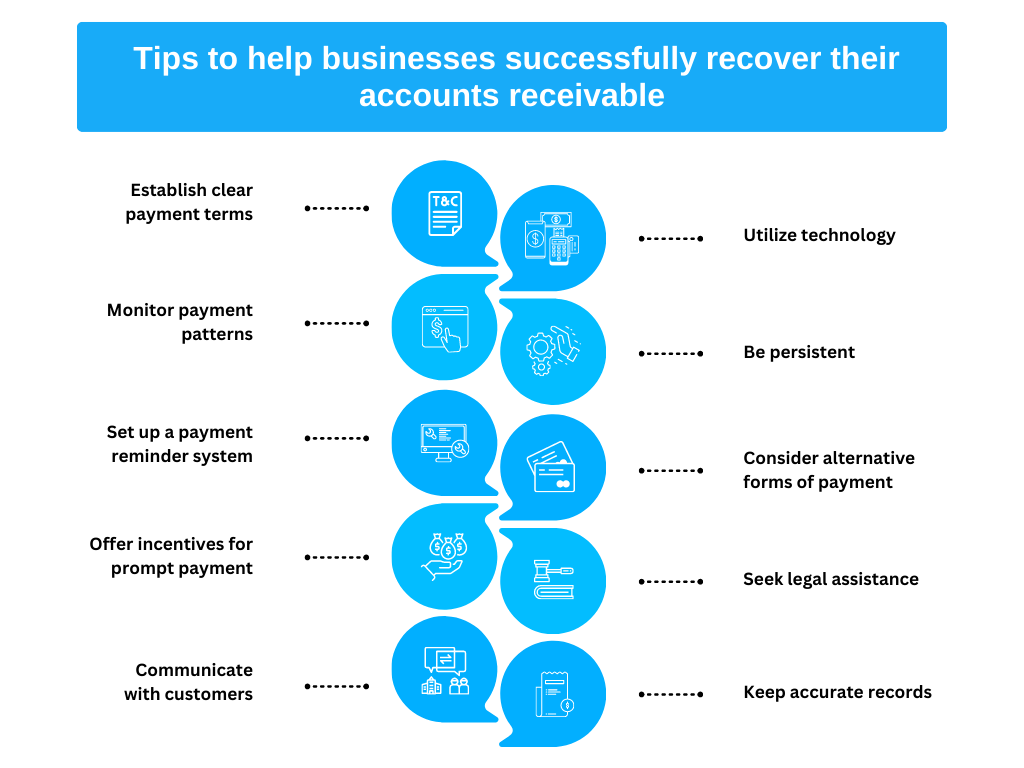Tips for Accounts Receivable Recovery
Accounts Receivable Recovery is the process of collecting payment from customers who have purchased goods or services on credit. This process is an essential aspect of managing a business’s finances. It involves ensuring that customers pay their bills on time. And that any late payments or overdue accounts are collected effectively.
The goal is to minimize the risk of late or missing payments while maintaining positive customer relationships. This process typically involves establishing clear payment terms, monitoring payment patterns, sending payment reminders, and, if necessary, seeking legal assistance. Despite the best efforts of businesses to get paid on time, some customers may fall behind on their payments, leading to a need for accounts receivable recovery.
Tips for Accounts Receivable Recovery:
Establish clear payment terms:
It is essential to establish clear payment terms with customers from the outset, such as payment due dates, interest charges for late payments, and acceptable payment methods. This will help prevent misunderstandings and make it easier to enforce payment when necessary.
Monitor payment patterns:
Regularly monitoring the payment patterns of customers can help businesses identify potential issues early on, such as a change in payment habits or a decrease in the frequency of payments. This can give businesses time to take action before a customer fall too far behind on their payments.
Set up a payment reminder system:
Establishing a payment reminder system can help ensure that customers are aware of their payment obligations and that payments are received on time. This can be done through automated email reminders, text messages, or phone calls.
Offer incentives for prompt payment:
Offering incentives for prompt payment, such as discounts for early payment or a loyalty program for repeat customers, can help encourage customers to pay on time and improve payment patterns.
Communicate with customers:
Open and regular communication with customers can help identify and resolve payment issues before they become a major problem. Businesses should be proactive in reaching out to customers who are behind on their payments and work with them to find a solution.
Utilize technology:
Technology can play a significant role in accounts receivable recovery by automating payment reminders, tracking customer payment patterns, and streamlining the recovery process. Businesses can utilize accounting software, payment gateways, and other tools to improve their accounts receivable recovery process.
Be persistent:
Accounts receivable recovery can be a challenging and time-consuming process, but it is important to be persistent in pursuing payment. This may involve making repeated follow-up calls or sending reminders, but it is essential to stay focused on the goal of collecting payment.
Consider alternative forms of payment:
Offering alternative forms of payment, such as electronic transfers or online payment systems, can make it easier for customers to pay and improve payment patterns. This can also reduce the risk of late or missing payments and streamline the accounts receivable recovery process.
Seek legal assistance:
In some cases, it may be necessary to seek legal assistance to recover accounts receivable. This may involve engaging a collections agency or a lawyer or taking legal action. It is essential to understand the legal requirements, processes, and the costs and potential risks involved.

Keep accurate records:
Maintaining accurate and up-to-date records of payments and payment patterns is essential for effective accounts receivable recovery. This can help businesses identify potential issues early on, track payment progress, and support any legal action necessary.
Conclusion
By following these tips, businesses can successfully recover their accounts receivable and maintain the financial health of their business. It is important to understand that accounts receivable recovery is an ongoing process. And that it is important to regularly review and refine strategies in order to stay ahead of payment issues.
In conclusion, accounts receivable recovery is an important aspect of managing a business’ finances. And it can be achieved through a clear and effective strategy in place. By following the tips outlined in this article, businesses can successfully collect payments from customers.
This can help maintain the financial health of the business, support growth, and ensure long-term success. The key to successful accounts receivable recovery is to be proactive, persistent, and prepared, and to utilize technology and other tools to support the process. By doing so, businesses can improve payment patterns, minimize the risk of late or missing payments, and secure their financial future.
Try our Debt Resolution solutions today Request a Demo